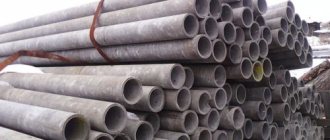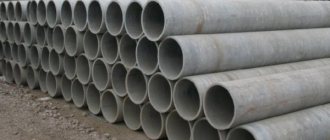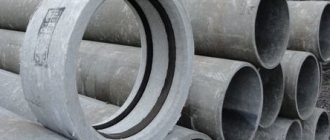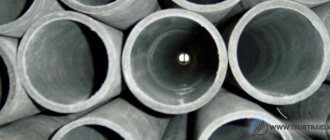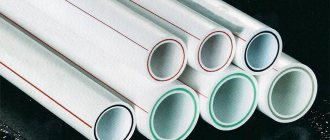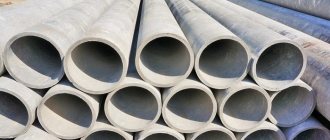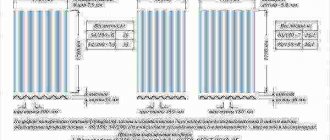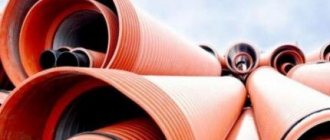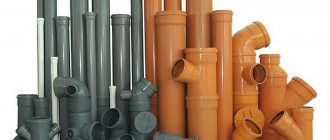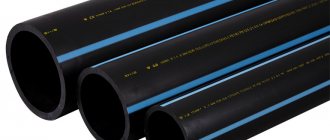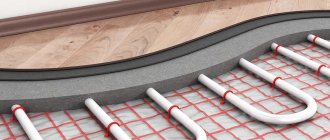After reading this article, you will understand: what chrysotile cement pipes are and what they are intended for, what are the differences from asbestos-cement collectors. What GOST standards and certificates exist. How to install correctly and what range of products. And much more.
First of all, chrysotile cement pipes are very reliable and, at the same time, cheap parts from which pipelines for various purposes are installed.
To produce products, a mixture of cement, asbestos, and water is used. In order to protect against mechanical damage and for the reinforcement of pipe elements, the manufacturer uses asbestos fiber, the share of which is 20.0% of the total mass of the part.
Important! The production of chrysotile cement pipes involves the presence of a harmless type of white asbestos - chrysotile, in contrast to amphibole asbestos, which is very toxic and prohibited for use.
Technical characteristics and properties
All substances from which rolled pipes are produced have certain properties. Chrysotile cement pipes were no exception. The main regulatory legal act is GOST 31416-2009, which defines the technical conditions for chrysotile cement pipes and couplings.
Among the technical characteristics of chrysotile cement are:
- waterproof;
- resistance to mechanical damage;
- increased strength.
The main differences between chrysotile cement pipes according to GOST 31416-2009 from analogues made from other materials:
- the ability to function efficiently at pressures up to 58 atmospheres and temperatures above +200℃;
- long service life (up to 50 years or more);
- increased resistance to corrosion and chemically active environments;
- low coefficient of friction, which contributes to almost ideal transportation of debris and liquids;
- simplicity and high speed of installation;
- breadth of assortment;
- acceptable price.
The low thermal conductivity of the substance makes it possible to use chrysotile cement parts when laying heating mains. High waterproofing characteristics make it possible to install pipelines in soil with high humidity.
In addition, the low weight of chrysotile cement pipes and increased strength contribute to easy warehousing, storage and transportation.
Storage and transportation
Storage and transportation of chrysotile cement pipes is carried out taking into account certain rules. Chrysotile cement products are laid in stacks and it is very important that the parts in the stacks stand on a flat surface.
If the surface on which chrysotile cement products are stored is not smooth and has protrusions and depressions, then care should be taken to provide a wooden lining. In this case, the bottom row of pipes must be securely fastened. When transporting chrysotile cement parts, you must remember that they must be securely fixed before transportation.
These pipes must be handled with care to prevent them from falling and should be stored on a level surface.
Unloading of these products is carried out carefully. Under no circumstances should you simply throw products out of the back of your car.
Linear dimensions and markings
Chrysotile cement pipes are universal. The samples have found application in the construction of stormwater, water supply, and heat-conducting structures.
Important! The abbreviation BNT means that we are dealing with chrysotile cement free-flow pipes. Pressure analogues are marked VT or TT. Accordingly, the designation of couplings for products of the first type is BNM, and for the second type of risers is TM or CAM.
Gravity sewer and drainage mains, other underground communications, chimneys are also installed from chrysotile cement pipes BNT 100, BNT 150, BNT 200, BNT 250.
Chrysotile cement free-flow pipes BNT 400 and BNT 300 are indispensable when constructing waste chutes. With their help, columnar foundations are built.
The most popular parts are length 2.95; 3.95; 5.00 m. Outer diameter values: from 100 to 500 mm, with wall thicknesses from 8 to 26 mm, pressure and non-pressure BNT (BNT - thin-walled) parts with a cross section of 150, 200, 250, 300, 350, 400 mm, corresponding current GOST 31416-2009.
Types of products
The range of pressure chrysotile cement pipes includes parts with lengths of 2950, 3950, 5000, 5950 mm. There are products with nominal diameters of 100-500 mm. This type of pipe is characterized by the concept of “outer diameters of machined ends.” The parameter can vary from 122 mm (for 100 mm nominal bore) to 528 mm (for risers with a 500 mm nominal bore).
More details about the geometric dimensions are in tables 1 and 2.
Table 1. Geometric dimensions of free-flow chrysotile cement risers
| Nominal diameter, mm | Outer diameter, mm | Wall thickness, mm | Length, mm | |||
| BNT | BNTT | BNT | BNTT | BNT | BNTT | |
| 100,0 | 118,0 | 116,0 | 9,0 | 8,0 | 2950,0 | 3950,0 |
| 150,0 | 161,0 | 161,0 | 10,0 | 9,0 | 2950,0 | 3950,0 |
| 250,0 | 266 | 259 | 14,0 | 12,0 | 3950,0 — 5000,0 | 3950,0 — 5000,0 |
| 300,0 | 309,0 | — | 15,0 | — | 3950,0 — 5000,0 | — |
| 320,0 | — | 14,0 | — | 3950,0 — 5000,0 | — | |
| 400,0 | 402,0 | 394,0 | 17,0 | 17,0 | 3950,0 — 5000,0 | — |
| 407,0 | — | 17,0 | — | 3950,0 — 5000,0 | — | |
| 427,0 | — | 25,0 | — | 3950,0 — 5000,0 | — | |
| 500,0 | 474,0 | 503,0 | 22,0 | 24,0 | 3950,0 — 5000,0 | 3950,0 — 5000,0 |
| 514,0 | — | 24,0 | — | 3950,0 — 5000,0 | — | |
Table 2. Geometric dimensions of pressure chrysotile cement risers
| Nominal diameter, mm | External section of machined ends, mm | Inner diameter, mm | Length, mm | |||||
| TT3 | VT6 | TT10 | TT9 | VT15 | TT16 | |||
| 100,0 | 122,0 | 104,0 | 94,0 | 96,0 | — | 92,0 | 2950 3950 5000 | |
| 150,0 | 168,0 | 146,0 | 132,0 | 135,0 | — | 128,0 | 2950 3950 5000 | |
| 250,0 | 274,0 | 244,0 | — | 228,0 | — | — | 5000 | |
| 300,0 | 324,0 | 289,0 | — | 270,0 | 256,0 | — | 3950 5000 5950 | |
| 400,0 | 427,0 | 381,0 | — | 356,0 | — | — | 3950 5000 | |
| 500,0 | 528,0 | 473,0 | — | 441,0 | — | — | 5000 | |
| 476,0 | 444,0 | 450,0 | 436,0 | 428,0 | ||||
Important! The internal diameters are reference values, and the machined ends should not be shorter than 200 mm for all risers, depending on the length of the couplings used to connect chrysotile cement pipes in accordance with GOST 31416-2009.
The ability to decipher markings and symbols helps any client correctly and quickly select the required product.
First about labeling
The outer side of chrysotile cement pipes that comply with GOST 31416-2009 is distinguished by the trademark or name of the manufacturer. Next comes information about the product class, nominal diameter, and batch number. It is possible to use labels that are glued to the outside of the parts.
The designation of a chrysotile cement pressure pipe (coupling) for water pipelines and reclamation (drainage) structures (VT) must also contain information about the class of the product, the diameter of the nominal diameter (DN and not d, in mm), its length (mm), compliance with the current standard .
For example:
1. Chrysotile cement pressure pipe (drainage) class VT6 with a nominal diameter of 300 mm and a length of 5950 mm is conventionally designated as follows:
VT6 300 – 5950 GOST 314162009.
2. Chrysotile cement free-flow pipe of BNT class with a nominal bore of 250 mm and a length of 5000 mm: BNT 250-5000 GOST 314162009.
Price for chrysotile cement non-pressure couplings
| Name | Internal and external diameter, mm | Coupling weight, kg | Coupling price, rub. |
| BNM 100 | 140-160 | 1.4 | 180-00 |
| BNM 150 | 189-213 | 2.3 | 235-00 |
| BNM 200 | 221-249 | 5.1 | 300-00 |
| BNM 250 | 238-326 | 6.4 | 380-00 |
| BNM 300 | 324-356 | 7.6 | 430-00 |
| BNM 400 | 422-458 | 11.5 | 570-00 |
| BNM 500 | 525-575 | 16.3 | 890-00 |
For detailed information about the availability and delivery conditions of goods, please contact the sales department using the special form below or by phone;
8(499)922-09-01 Online form
Mechanical characteristics of products
Non-pressure
Non-pressure chrysotile cement parts are designed for test hydraulic pressure ≥400 kPa.
Mechanical characteristics of products
When samples are filled with water, they are able to withstand certain crushing loads.
Table 3. The value of the minimum test loads for crushing non-pressure products
| Nominal diameter, mm | External diameters, mm | Minimum test loads, kN | ||
| BNT | BNTT | BNT | BNTT | |
| 100,0 | 118,0 | 116,0 | 4,508 | — |
| 150,0 | 161,0 | 161,0 | 3,920 | — |
| 250,0 | 266,0 | 259,0 | 3,626 | 3,600 |
| 300,0 | 309,0 | — | 4,116 | — |
| 400,0 | 402,0 | 394,0 | 4,900 | 5,100 |
| 500,0 | 474,0 | 503,0 | 5,390 | 6,100 |
Pressure
The elements are characterized by increased water resistance and durability. The values of hydraulic test pressures for water permeability, destruction, crushing of pressure elements must correspond to the data from tables 4, 5 and 6, respectively.
Pressure
Table 4. Hydraulic test pressure values for water permeability
| Pipe class | Coupling class | Hydraulic pressure value, kPa |
| VT6 | CAM6 | 1200 |
| VT9 | CAM9 | 1800 |
| VT12 | SAM12 | 2400 |
| TT10 | TM10 | 2000 |
| TT12 | TM12 | 3000 |
| TT16 | TM16 | 3200 |
Table 5. Hydraulic pressure values when testing pressure pipes for destruction
| Nominal diameters, mm | Hydraulic pressure value, kPa | |||||
| VT6 | VT9; TT6 | TT9 | TT10 | TT12 | TT16 | |
| 100,0-125,0 | 2400 | 3600 | 4800 | 4500 | — | 5800 |
| 150,0-200,0 | 2100 | 3100 | 4200 | 3700 | 5200 | 6000 |
| 250,0-500,0 | 1800 | 2700 | 3600 | 3200 | 4500 | 5300 |
Table 6. Minimum loads when testing pressure pipes for crushing
| Nominal diameter of pipes, mm | The value of the minimum test loads, MN, for pipes of classes | |||||
| VT6 | VT9 | VT12 | TT10 | TT12 | TT16 | |
| 100,0 | 0,008 | 0,011 | 0,013 | 0,012 | — | 0,016 |
| 200,0 | 0,008 | 0,012 | 0,017 | 0,013 | 0,025 | 0,030 |
| 300,0 | 0,009 | 0,014 | 0,022 | 0,016 | 0,030 | 0,034 |
| 400,0 | 0,015 | 0,018 | 0,029 | 0,021 | 0,039 | 0,045 |
| 500,0 | 0,016 | 0,022 | 0,034 | 0,025 | 0,039 | 0,045 |
ADVANTAGES OF CHRYSOTHYLE CEMENT TUBULAR PRODUCTS
Pipes for heat supply, water supply and drainage are made from various materials. They can be cast iron, plastic, steel, chrysotile cement (asbestos cement), ceramic. Each material has its disadvantages. Thus, ceramic products are quite fragile, cast iron products are heavy and prone to flooding. Polymer options are fragile, steel ones are expensive.
Perhaps chrysotile cement pipes have the greatest number of advantages. Chrysotile cement has many advantages. This material:
- affordable;
- highly durable;
- durable (the service life of chrysotile cement products is more than 30 years);
- resistant to temperature changes in the range from -70 to +70 degrees;
- absolutely non-flammable and does not support a flame (NG group);
- resistant to aggressive environments and chemical influences;
- not subject to corrosion and rotting.
A pipe made of chrysotile cement does not require waterproofing if the connection is airtight. The walls do not allow moisture to pass through. The product can withstand pressure up to 1.6 MPa.
Chrysotile cement pipes are not prone to silting, and since they do not rust, there will be no “overgrowth” from the inside. They are characterized by low thermal conductivity and electrical conductivity. Such pipes do not form condensation if used for cold water supply, and do not require cathodic protection.
Chrysotile cement and asbestos cement pipes: similarities and differences
Similarities
Although there are some differences among the details, the similar chemical composition of the materials determines the similarity of chrysotile cement and asbestos cement risers:
- neutral to corrosion processes, which facilitates installation of systems in a humid environment;
- have slight linear expansion when exposed to low or high temperatures.
Both types of parts are characterized by:
- increased fire safety;
- low thermal conductivity (much less compared to metals);
- smoothness of the inner surface, which eliminates the formation of build-ups and deposits and ensures the unhindered movement of working fluids and solid materials;
- high dielectric properties;
- resistance to low temperatures, which allows the installation of highways in frosty regions;
- immunity to aggressive environments, including alkalis and acids; long term of high-quality functioning;
- low cost compared to metal samples.
Differences
Despite the equal demand for chrysotile cement and asbestos cement pipes, there is a difference between these products. The first type of risers are completely environmentally friendly. Therefore, over the past twenty years, the use of parts in various spheres of human activity has been observed. They are used in the construction industry and agriculture.
The products are an excellent design option for arranging the local area. In some cases, they can be used for the installation of water supply and sewerage networks.
In turn, asbestos-cement pipes (TA with a wall thickness of 10 mm or more) are characterized by increased heat resistance and high strength.
The products are distinguished by their aesthetics, efficiency, and budget price.
Rocket science, nuclear energy, and the chemical industry cannot do without them.
When cutting parts, toxic dust is generated, which can adversely affect your health.
Important! Proper respiratory protection and careful compliance with TB requirements are the solution to a possible problem.
Chrysotile cement and asbestos cement pipes, including BNT with a diameter of 100 to 500 mm, meet the sanitary and hygienic requirements that apply in Russia.
Chrysotile cement and asbestos cement products are selected depending on the purpose of use.
To choose the right parts, you need to know in what conditions they will function and what kind of work they will perform. Since there is a slight difference between chrysotile cement and asbestos cement pipes, they are also used slightly differently.
Product Features
Asbestos (or hydrous magnesium silicate) is a material that has been known for several hundred years. There are two types of this raw material, which have differences in composition:
- chrysotile (white asbestos);
- amphibole asbestos.
The amphibole type is not used for the production of pipes, as it is carcinogenic and harmful to human health. There is a ban on the mining of amphibole asbestos. Chrysotile is not a toxic substance, so it is used for various needs, including the production of pipe products. White asbestos has no toxic properties and is non-radioactive.
Chrysotile cement pipes contain asbestos fibers that are packed into a concrete matrix. In the last century, these pipes were used quite rarely, as they were considered carcinogenic. The then GOST allowed their use only for land reclamation. Today, the properties of this material have been well studied and it is used in many areas of life.
There is a “Code of Rules for the Design and Laying of Underground Utilities”, in which chrysotile cement products have the second category of reliability for heat supply, which allows them to be used for laying industrial and utility heating networks.
Note! When installing heating systems made of chrysotile cement, it must be remembered that the pressure of the working medium should not exceed 1.6 MPa, and the temperature should not be higher than 150 °C.
The use of chrysotile cement pipes is permitted by the Ministry of Health of the Russian Federation. Their use is regulated by relevant documentation (Hygienic standards GN 2.1.2/2.2.1.1009–002).
Such pipes are allowed to be used for laying water supply lines
To date, more than 3 million kilometers of communications have been laid from this material. Moreover, more than 1 million are in Russia. Gas pipelines made from chrysotile cement products are also common in Europe. The first chrysotile cement water supply system was installed on the territory of our country in 1965 in the Saratov region. This water supply system still works to this day, which proves the high performance qualities of this material.
Where are chrysotile cement pipes used?
There are pressure and non-pressure chrysotile cement parts.
Non-pressure elements can be:
- conventional – marked BNT;
- thin-walled - marked BNTT.
These chrysotile cement pipes (CCP) have found their application:
- when constructing drainage reclamation collectors. Most often they use BNT 100, BNT 150, BNT 200, corresponding to GOST 31416-2009. In some cases, drainage parts of large diameters (d) are used - 400 and 500 mm;
- in gravity sewer systems. Products with a cross section from 100mm to 500mm are used. Among plastic analogues in private construction, the most popular are elements with a diameter of 50 and 110 mm;
- for installation of ventilation communications; as chimneys and garbage chutes. Products of large diameters are used - 250-500 mm.
Important! When installing chimney structures, it is necessary to take into account that safe operation of chimneys is possible at temperatures of exhaust gases up to +295 - +300℃.
Therefore, it is not recommended to use chrysotile cement pipe BNT 150 or other sections in a coal stove.
BNT pipe parts are often used when installing cable channels as protection.
Modern construction cannot do without these products. If you plan to build a house that will have light panel, frame or wooden walls, then columnar monolithic foundations are built using tubular products. For this purpose, according to GOST 314162009, chrysotile cement pipes with a cross section of 200, 150 and 100 mm are suitable.
Similar elements have found their application in low-rise construction. Depending on the material from which the walls will be constructed, chrysotile cement risers with a larger diameter are used - 300, 400 and 500 mm. In this case, the pipes are reinforced, then a concrete mixture is poured into them and a high-strength monolith is obtained.
To make the surrounding area look attractive and modern with minimal financial investment, BNT pipes made of chrysotile cement are also used. Arrangement of columns, urns, pillars (with plugs), flower beds is an incomplete list of the use of cylindrical parts.
Important! For greater stability and strength of products, the internal volume is covered with sand or weighted with concrete, especially in cases where they are part of supporting structures.
When sawing risers longitudinally, the resulting parts are used as rain gutters, decorative fence elements, and gutters.
If we compare the pressure chrysotile cement riser 300 with its non-pressure counterpart, the first option is characterized by higher strength. The products are used in pipelines for supplying cold and hot water. They are used for laying heating mains, heating mains, and oil pipelines. Pressure samples can always replace non-pressure analogues.
Important! Building regulations allow the installation of mains from pressure pipes both in residential premises and in public buildings.
But in children's institutions, hospitals, special industries, where heat must be supplied continuously, heating structures using pressure risers made of asbestos cement cannot be installed.
Application
Asbestos cement sheet as formwork - convenient and beautiful.
Asbestos cement sheets are used as a material:
- Roofing (flat slate).
- Structural.
- Finishing.
Pressed sheets are used for roofing. Flat slate is used to cover garages, outbuildings, production and storage facilities, country houses, and small residential buildings.
Pressed sheets are used for lining cooling towers - cooling devices of thermal and nuclear power plants. They are used for the construction of trade tents, pavilions, and bus stops. The sheets are used to cover the external walls of residential buildings and industrial buildings.
Unpressed slate, being less durable, is used more often for interior work. Used for cladding loggias, balconies, partitions. Summer residents and gardeners fence beds and flower beds with asbestos cement sheets and lay out compost pits.
Watch a video about how asbestos cement sheets are produced:
Requirements for products according to GOST 31416-2009
GOST 31416-2009 presents all the requirements for chrysotile cement pipes and couplings.
Products are considered to be of high quality if they are free of chips, cracks, and delaminations. The ends must be cut strictly at right angles to the pipe axis.
Pressure parts must have tapered ends with a turning angle of 20° to 25°. The inner surface of the couplings must also be machined. There should be no dents or tears inside the risers and couplings.
External unmachined surfaces may have a small number of minor abrasions and dents, the depth of which does not significantly affect the quality of the parts:
- for pressure products - up to 1.0 mm;
- for non-pressure parts – up to 2.0 mm.
The elements may contain:
- prints from technical types of cloth;
- minor chips at the ends with a depth of up to 2.0 mm and a length of up to 20.0 mm along the products;
- turning marks up to 2.0 mm deep.
Details should not be crooked. Minor deviations from straightness are permitted and are summarized in Table 7.
Table 7. Permissible deviations from straightness
| Pipe type | Length, m | Possible deviation, mm |
| Gravity | 2,95 | 12,0 |
| 3,95 | 16,0 | |
| 5,00 | 20,0 | |
| Pressure | 2,95 | 12,0 |
| 3,95 | 12,0 | |
| 5,00 | 18,0 | |
| 5,95 | 24,0 |
Important! During hydraulic tests of at least 400 kPa, no water should appear on the outer surface of chrysotile cement pipes according to GOST 31416-2009! Only in such cases can they be considered waterproof.
From a safety point of view, a number of requirements for parts are also met. They are non-flammable, non-explosive and harmless to health.
During mechanical processing of risers and couplings, chrysotile cement dust may be released (hazard class IV - “Low hazardous substances”). If we consider that there are only 4 hazard classes, then chrysotile cement dust belongs to the last option - the least dangerous substances. For safe handling of parts, respiratory organs should be covered with personal protective equipment.
Important! The process of processing products is carried out using a blade cutting tool and in no case with an abrasive device.
Asbestos cement
Asbestos is a mineral fiber of natural origin that strongly reinforces a cement pipe. The carcinogenic dust generated during processing is harmful to health. Penetrating into the body, it accumulates in the lungs and leads to serious illnesses. Respiratory protection can solve the problem. It is sufficient to use respirators during production and installation. During operation, the pipes do not pose any danger.
Certificate or quality passport
Pipe chrysotile cement products, pressure or non-pressure BNT 100, BNT 150 and other sections, must comply with GOST 31416-2009.
As confirmation of high quality, a certificate of compliance with certain criteria is issued for the product. We are talking about a certificate of conformity or a quality passport, as it is also called.
In accordance with technical and hygienic operating standards, drinking water supply can be installed from chrysotile cement parts. At the same time, for such use of risers they must be certified by the relevant organizations. The Customs Union has adopted uniform rules according to which drinking water supply is controlled by sanitary supervision.
To obtain a quality passport, you must first obtain a special Certificate, which will state that the products do not emit radiation. The presence of this document indicates that specific parts do not contain radionuclides, or are present in the minimum amount that is allowed for such products.
For final conclusions it is necessary to test the products. After the procedure, substances hazardous to health (or their absence) are determined. Only after this the manufacturer can receive a certificate of conformity.
Where are chrysotile cement sheets used?
The main purpose is to create high-quality and reliable roofing in low-rise buildings, for office and shopping centers, as well as for the exterior decoration of industrial complexes and structures. In addition, this building material has proven itself well as an additional element in the construction of foundations and permanent formwork. Chrysotile cement sheets can also be used for installing so-called sandwich panels in summer cottages and gardens (for example, as fencing), for the construction of small cabins, extremely simple partitions. Chrysotile panels are an excellent finishing building material for arranging balconies and loggias. You can build a fairly strong parapet from it.
Features of installation and joining of chrysotile cement pipes BNT
The functioning of highways depends on the quality of the connection between its elements.
The algorithm for installing heating mains, drainage channels, sewer systems, gutters for laying cables is the same:
- Dig a trench.
- Deliver the required number of risers and couplings of the required diameter (d).
- Visually inspect the products for integrity.
- Place the necessary elements in the trench.
- Inspect the installed line.
- Test the track for tightness and cross-country ability.
- Backfill the trench.
Important! Do not place parts at the bottom of a dug trench. In order for the load on the risers to be distributed evenly along the highway, it is necessary to first make a cushion of sand 5-7 cm thick.
Install the pipeline with a slope of 2-4 mm per 1 linear meter. It is necessary for transporting “wet” or “dry” substances.
For example, it is needed not only for the sewer route, but even for laying wires. The fact is that without a slope, moisture may accumulate in certain places, which will reduce the service life of the system.
Pipe installation
When installing a pipe, equipment is needed only at the stage of supplying the pipe to the place of its fixation. The docking process itself is done manually. Only hand tools are used for connection.
When using prolonged connections, it is necessary to grind the edges to increase the adhesion of the material and carefully secure the couplings.
When using rotary nodes in a communication system, cubes are used. In installation, a “cube” means a cubic-shaped product with a distillation chamber. The inside of the cube contains a metal (steel) flask. Thanks to this product, straight pipes can be connected into a complete system.
offers asbestos-cement pipes at low prices.
A little about couplings
The joining of individual elements into a single whole can be carried out by several types of couplings. The most popular and in demand include:
MPT (metal-polymer)
Used for joining products with a cross-section of 100-300 mm, used for laying cables. The connecting elements have a ribbed internal profile, due to which a reliable hermetically sealed connection is formed.
To pull the product onto the riser, you must first warm it up for 10-12 minutes in water at a temperature of +95-100℃. During the cooling process, shrinkage and tension of the coupling occurs. A special polymer is used to make it.
MPT (metal-polymer)
It can also be used for installing structures in dry soil. To do this, use a polyethylene MPT coupling with an internal partition to connect the ends.
Docking scheme:
a) the part is heated with a blowtorch so that it expands slightly and becomes plastic. The procedure can also be performed using boiling water, since the operation requires heating the connecting part to +100℃. But it takes a long time and is a little dangerous. Therefore, it is easier to heat the part with an open flame.
b) put the hot coupling on the riser until it stops.
c) on the other side, insert the second element until it stops.
Important! After making the connection, you must wait for the connection area to cool down. Only after some time has passed can the product be used.
BNM (chrysotile cement)
It is used when installing highways in any soil. If according to the plan it is only necessary to maintain a straight line of the main line, then to connect with a free-flow coupling it is not necessary to stock up on binding materials. Otherwise, for better articulation of elements and tightness, you can use bitumen, mastic, cement-sand mortar.
Important! For safety reasons, in order to avoid mechanical damage, you should use a crane or your own strength to perform installation work. In this case, all movements should be smooth, without sudden impacts.
Docking using a BNM coupling
Most often, hot bitumen is used, since the molten substance seeps into all holes and the joint will be airtight.
Docking diagram
Scheme A – placement of BNM with holes before installation, diagram B – after installation work with coupling length – L , installation gap – l.
The numbers indicate:
1,2 – free-flow element, 3 – coupling, 4 – bitumen or other binder mixture, 5 – tow or hemp,
To correctly install the coupling, it is necessary to mark the location of its placement on the BNT. To do this, the BNM is centered around the circumference, placing wood chips in the right places. It is important that there is a small gap between the risers (from 3 to 5 mm), since it will be filled with a binder, which will act not only as a sealant, but also as a buffer.
Before pouring bitumen, hemp or tow is pushed into the installation gap. And only then the upper holes are filled with liquid binder. If the solution begins to flow out from the opposite side, this means that the cavity is filled to capacity, which means the work has been done efficiently.
The edges of the joints are wrapped with a special resin-type tape.
When using a cement-sand mixture, holes do not need to be drilled in the BNM, but it is simply placed on top of the mortar laid around the perimeter of the circle. After this, the edges of the joint are sealed with the same composition.
The system can be used after the binders have completely cured, and this should happen naturally.
The elements of the high-pressure line are joined using chrysotile cement couplings according to the principle of self-sealing. Its essence: the joining of pressure elements using BNM couplings becomes absolutely sealed, thanks to the internal pressure of the transported medium.
The choice of connecting part depends on the operating pressure in the line. Thus, at pressures from 6 to 15 technical atmospheres (with a gradation of 3 atm), couplings with 2 or 4 grooves for sealing rings are used.
Rings
Starting from 16 atmospheres, the parts are connected with longer couplings. Their feature is the presence of two wider grooves for rubber sealing rings, which are included in the kit.
The lines are installed using duct and non-duct methods. This means that the pipeline can be laid underground and on the surface.
With underground installation, the most popular, all the positive technical characteristics of the material are fully used. And they look quite aesthetically pleasing.
With the channelless method of installing routes, there are restrictions: you cannot install lines in places where tram and railway lines run above, or under residential buildings.
One of the disadvantages of outdoor routes is the use of large usable areas. But this installation option is needed if it is technically impossible to lay an underground pipeline. In such cases, special supports are used—cradles placed on both sides. The element is placed on a steel strip, which is tensioned between the supports.
Installation
Gibot/Jabot (cast iron)
Gray cast iron is used for manufacturing. With their help, elements of highways are joined, which can be separated at the flanges.
This coupling is a complex multi-component product, consisting of 2 flanges to which bushings are welded (they can be cast), an insert and 2 rubber sealing rings.
Cast iron couplings for connecting risers
Docking Features
There are several options for joining chrysotile cement pipes. The most popular of them is the coupling method. Polyethylene couplings (MPT) are capable of joining two ends of pipes. Docking is carried out by heating the coupling - it is placed in a container with water heated to 90–100 ° C and kept in such water for at least 10 minutes. Then the hot coupling is put on the chrysotile cement part at one end, and the second pipe is inserted from the opposite side. This is a very convenient and fairly simple method of installing communications.
For joining chrysotile cement pipes, couplings, bends, and tees made of the same material are used
But it is worth remembering that this method is used for installing pipeline structures under normal conditions, when the soil is dry. On wet soil, the individual elements of the chrysotile cement structure are connected using chrysotile cement couplings, which are then filled with hot bitumen.
As a rule, butt welding equipment is not required for laying an asbestos-cement pipeline. Special equipment is used only if the pipes have a large diameter and are massive. The joining of such parts to each other is carried out using polyethylene or chrysotile cement couplings. Adjustment of pipe ends to the required dimensions or turning occurs at the production stage. Turning of the end of the part is carried out taking into account what roughness a pipe with a certain diameter should have.
One of the structural elements of the couplings is an o-ring, which provides excellent joint tightness. It is worth noting that there is a small gap between the pipe and the special coupling. The elasticity of the seal and the free gap allow the desired bending of the structure (up to 3°).
Helpful information! All the main provisions for laying pipelines from this material can be read in SP 41–106-2006.
Chrysotile cement pipes are produced in straight sections, so not so long ago the components for such pipelines were made of steel, and a special thermal chamber was mounted on each turning section or branch. However, now there is an excellent solution to circumvent these difficulties - a special normal, which is a set of concrete cubes.
Chrysotile cement pipes can also be joined using special collector blocks
These concrete cubes enclose a connection, that is, a coupling. The concrete cube also performs a protective function, preventing moisture from reaching the steel elements. However, even if the steel collapses due to the destructive effects of corrosion, such a unit will continue to work, since the channel made in the concrete cube will remain intact. This standard is multi-profile and can be used for pipes with different cross-sectional indices.
When installing asbestos-cement or polyethylene couplings, special manual devices are used that simplify installation work. Today, these devices are the third modification and are constantly being improved. There are tools that allow you to adjust the chrysotile cement pipe to the seal. With the help of such manual devices, it is possible to quickly turn the pipe under the sealing ring right at the site of the pipeline assembly. In order to divide such a product, use a regular hacksaw for metal.
Production, storage, transportation of chrysotile cement pipes
Manufacturers of elements for their production use the Hatchek/Mazza method, which consists of mixing Portland cement with chrysotile asbestos fibers in a 4:1 ratio. The fibers must be of different lengths.
The mixture is poured into a constantly rotating sieve cylinder, where the composition is dehydrated and a thin layer of chrysotile cement is formed. The core is wrapped with this material to the required wall thickness. After this, the ends of the finished riser are processed on a special sharpening machine. At the very end, couplings are put on the ends for joining.
It is very important that the manufacturer adheres to the rules and technical standards during the production process. Then the products will not only be of high quality, but also attractive.
The leading Russian producers of BNT include:
OJSC Belgorodasbestocement, LLC Volna Plant (Krasnoyarsk), OJSC SKAI (Volgograd Region), OJSC LATO (Republic of Mordovia). All enterprises have certificates of conformity for their products.
There are certain rules for storing and moving chrysotile cement pipes that comply with GOST 31416-2009. The parts are stored in stacks, which are placed on level areas.
If the surface is uneven, it is necessary to level the storage area using wooden pads. The bottom row must be fixed so that the products are immovable. Parts must be secured before transportation.
Unloading work is also carried out carefully so as not to damage the elements. To keep them safe and sound, it is strictly forbidden to throw products on the ground.
The approximate cost can be viewed at the link: https://www.complexs.ru/jbi/view/pid/252626
Laying chrysotile cement pipes: pros and cons
Today, the domestic market offers a huge selection of pipes made from different materials. Each type of product has advantages and disadvantages that can play a significant role during operation.
It is for this reason that when designing utilities, it is necessary to carefully evaluate all the pros and cons of using chrysotile cement pipes.
The choice in favor of these asbestos products is due to their following advantages:
- resistance to corrosive processes and the effects of stray currents;
- ability to withstand different types of bends;
- excellent water resistance;
- even under increased mechanical loads they are difficult to crush;
- can withstand pressure up to 5.8 MPa without problems;
- long service life, sometimes exceeding 25 years;
- connecting pipes into a system is considered to be a simple job;
- affordable price;
- the thermal conductivity coefficient is 100 times less than that of steel pipes;
- products are produced with different diameter sizes, so choosing the best option for creating a specific pipeline is not difficult;
- minimal costs for installing thermal insulation. Communications do not need to be placed in protective trays - filling with crushed stone will be enough;
- resistance to the influence of aggressive environments;
- ease of installation;
- application for laying pipelines for various purposes - it does not matter what type of liquid will move through them.
Due to the multiple advantages of chrysotile cement pipes, they are used in the construction of storm sewers, hot or cold water supply systems, arrangement of drainage collectors and heating installations.
These products also have disadvantages:
- in order to move or install large-diameter pipes that have significant weight, it is necessary to use special lifting equipment, and this affects the financial side of the installation work and therefore they are considered expensive;
- Since there is a high probability that the products are counterfeited and do not meet the standards, you should request a quality certificate for them when purchasing products.
Reference weight of pressure pipes
| Conditional diameter of pipes Dу, mm | Reference weight, kg, 1 m pipe length class | |||||||||
| TT3 | VT6 | TT6 | VT9 | TT9 | TT10 | VT12 | TT12 | VT15 | TT16 | |
| 100 | 7,8 | 9,3 | 9,2 | 10,6 | 11,7 | 10,4 | — | — | 12,5 | |
| 125 | 9,0 | — | 10,5 | — | 12,0 | — | — | — | ||
| 150 | 12,9 | 15,5 | 15,2 | 18,3 | 20,3 | 17,9 | 22,5 | |||
| 200 | 22,1 | 27,0 | 26,4 | 31,9 | 33,3 | 31,2 | 32,5 | 36,2 | 38,3 | |
| 250 | 28,4 | 36,6 | 35,9 | 42,0 | — | 41,1 | 43,7 | 47,3 | — | |
| 300 | 40,2 | 50,5 | 49,4 | 58,7 | 62,7 | 57,9 | 61,3 | 69,4 | 72,4 | |
| 350 | — | 50,9 | — | 63,7 | — | — | 76,5 | — | 87,5 | — |
| 400 | 68,8 | 86,4 | 84,7 | 100,8 | 106,9 | 100,6 | 105,6 | 114,8 | 125,7 | |
| 500 | 104,6 | 101,6 | 130,0 | 127,3 | 152,3 | 162,8 | 151,2 | 159,6 | 173,6 | 193,8 |
Notes:
| ||||||||||
Classification of pressure pipes and couplings, operating pressure
| Class | Class symbol | Working pressure value P, MPa | |
| pipes | couplings | ||
| 1 | TT3 | TM3 | 0,3 |
| 2 | VT6 | CAM6 | 0,6 |
| TT6 | TM6 | ||
| 3 | VT9 | CAM9 | 0,9 |
| TT9 | TM9 | ||
| 4 | TT10 | TM10 | 1,0 |
| 5 | VT12 | SAM12 | 1,2 |
| TT12 | TM12 | ||
| 6 | VT15 | SAM15 | 1,5 |
| 7 | TT16 | TM16 | 1,6 |
AREAS OF USE
The high quality characteristics of chrysotile cement pipes are evidenced by the fact that the length of pipelines laid from this material is more than four million kilometers. Initially, chrysotile cement products were used for reclamation systems. But thanks to their strength, lack of corrosion and other advantages, their areas of application have become more numerous. Pipes began to be used to create gas pipelines, water supply and sewer lines, and for heating networks.
Often, chrysotile cement products are used to create drainage and storm sewer systems that allow efficient drainage of surface-ground and groundwater. They make excellent drainage systems across roads and crossings, and drainage structures.
It is also possible to manufacture from chrysotile cement pipes:
- air ducts in exhaust ventilation systems;
- garbage chutes;
- channels for laying communication cables;
- wells and casing pipes.
In low-rise construction, chrysotile cement products are used for the installation of chimneys, as foundation elements (base pillars, permanent formwork), supports and columns. Pipes can become the basis for decoration - act as wall decorations, vases for flower beds.
